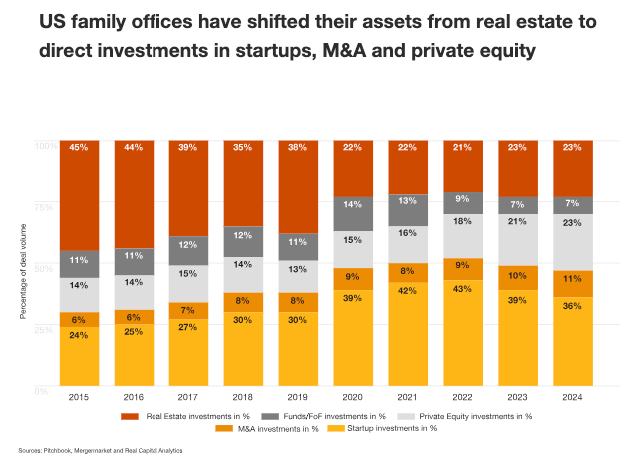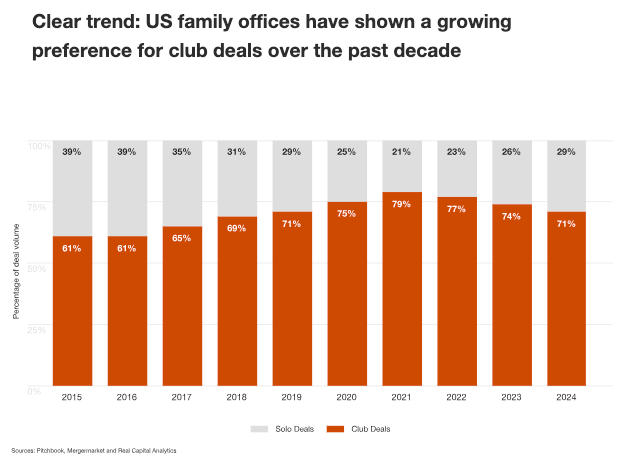If you've got $5 million to invest—or $50 million, or more—you've probably noticed something.
The best opportunities don't show up on Bloomberg terminals.
They're not in your private bank's quarterly model portfolio. They're not advertised on platforms with slick interfaces and one-click investing.
They're private. And they're happening without you.
If you wanted to explore private equity investing but didn't know where to start, you're at the right place.
Why 75% of family offices now skip traditional PE funds entirely
The three main ways to access private equity (and which fits your situation)
How club deals are reshaping private markets for wealthy investors
The real due diligence checklist that separates winning deals from disasters
Practical capital requirements and portfolio allocation strategies
Tax advantages that make PE more than just a returns play
Private equity—direct ownership in companies that don't trade publicly—has become essential infrastructure for serious wealth. Not speculation. Not diversification for diversification's sake. Infrastructure.
Here's what most people don't know: 75% of family offices are now investing directly or through club deals, bypassing traditional funds entirely.

The game has changed. But getting access takes more than capital.
You need relationships. You need a process. And you need to know what you're actually signing up for.
Let me show you how smart money is playing this game.
Why Smart Money Keeps Flowing into Private Equity
Let's start with the obvious question: why bother?
Returns That Actually Matter
Cambridge Associates tracks this data religiously. Over the past decade, U.S. private equity funds have delivered 15–18% net IRR. Compare that to public small caps at 10–12%.
That's net of fees. After the "2 and 20" gets taken out.
Past performance doesn't guarantee future results. We all know the disclaimer. But pattern recognition matters, and this pattern is hard to ignore.
The Illiquidity Premium (But Let's Be Honest About It)
You've heard about the "illiquidity premium"—the extra return you supposedly get for locking up your capital.
Studies suggest it's worth 3–5% per year.
But here's the reality check nobody mentions: not every private investment actually captures that premium. It depends entirely on your entry price, deal structure, and timing.
Just tying up capital for seven years doesn't magically create alpha. You need to buy well.
Tax Efficiency That Moves the Needle
This is where private equity gets interesting beyond the headline returns.
Done right, PE can be surprisingly tax-efficient:
QSBS exemption (Section 1202): Potentially exclude up to $10 million in gains from federal tax. Yes, really.
Step-up in basis: When you die, your PE holdings can reset their cost basis. All those unrealised gains? Gone from a tax perspective.
Estate planning leverage: The right structures, such as family partnerships, trusts, and carried interest structures, can shift substantial value without triggering gift taxes.
In other words, private equity isn't just about chasing returns. A large portion of returns can come from effective structuring and tax management.
The Three Ways HNW Investors Access Private Equity
Not all private equity looks the same, and there are different ways investors can get exposure to this asset class:
1. Traditional Fund Investing
The classic route. You commit capital as a Limited Partner (LP) to a private equity fund managed by a General Partner (GP).
The good: Professional management. Diversified exposure. Access to institutional-quality deals you'd never see alone.
The bad: Fees that sting (2% management, 20% carry). Blind pool risk—you're writing a blank check. Long lockup periods with zero liquidity.
The bottom line: Minimum commitments typically range from $1–5 million, though higher for large, well-established funds. You can go through feeder funds or platforms that pool capital, but that adds another layer of fees.
This works if you want passive exposure and rely on GP's experience and track record. You're paying for convenience.
2. Co-Investments
Think of these as sidecar deals. A fund manager invites you to invest directly alongside them in a specific transaction, usually with reduced or zero fees.
They do the diligence. You get deal-level visibility. You bring additional capital to help them close larger opportunities.
The good: Lower cost structure. More control over what you're actually buying. Clear visibility into each investment.
The bad: Time-sensitive decisions. You're trusting someone else's underwriting. You need existing relationships to even get the call.
The bottom line: Co-investing is the smart middle ground. You benefit from the GP's access and diligence work, but you skip most of the fund-level friction and fees.
3. Direct Deals
This is the DIY version. You source companies directly. No fund structure. No GP taking carry. You negotiate, structure, and own the whole thing.
The good: Total control. Custom deal structures. You keep 100% of the upside.
The bad: Sourcing quality deals is hard. Risk concentration is real. You need your own team—legal, financial, operational advisers.
The bottom line: Direct deals typically start at $5–10 million, though some minority growth investments can work at lower check sizes.
If you choose this path, you're building an investment office, not just making investments.
Club Deals: The Quiet Revolution in Private Markets
Now we get to the interesting part.
Club investing is where multiple high-net-worth investors or family offices pool capital into a single transaction. Think of it as a private consortium.
No fund overhead. No blind pool. Just collective buying power.
Why Club Deals Work
Scale: You can tackle $50 million opportunities without writing the entire check yourself.
Expertise: Each participant brings something—sector knowledge, operational experience, board governance skills, legal structuring expertise.
Transparency: You know exactly who you're investing with and what you're buying. No surprises.
According to PwC, over 70% of family office PE transactions in the U.S. are now club-based. This isn’t a trend—it’s a shift.

Real-World Example: How the Pros Do It
Look at the Visionaries Club in Europe. Founded by former operators, they bring together successful tech founders and major industrial families (Swarovski, Siemens family offices).
Their model: invest directly in startups and scale-ups, then actively help them grow using founder networks and corporate access.
It's alignment at its finest. Capital that actually adds value beyond the check.
This is what club investing looks like when done right.
Due Diligence: Separating Real Deals from Disasters
Once you're in the deal flow, how do you tell the difference between gold and garbage?
Here's your actual checklist:
Revenue Quality
Is it recurring or a one-off? What are the gross margin trends? Can prices be raised without losing customers? How sticky is the customer base and how difficult for them to switch?
Customer Concentration
If more than 20% of revenue comes from a single client, you've got a red flag. Maybe not a deal-breaker, but definitely a risk factor.
EBITDA Adjustments
Look closely at add-backs. Are they realistic or creative accounting? I've seen sellers add back "one-time" expenses that somehow happen every year, and there is also the "famous" community-adjusted EBITDA, "invented" by WeWork.
Working Capital
Watch for seasonality and unexpected expenses. Cash conversion matters more than EBITDA.
Cap Table Structure
Is ownership clean? Are there legacy claims, shadow equity, or unclear rights?
Legal and Compliance
Pending litigation? Unresolved regulatory issues? ESG risks that could explode later?
The Team You Need
Never, ever try to do this alone.
At minimum, retain:
- A seasoned M&A lawyer
- A quality-of-earnings accountant
- A tax planning specialist
- A sector expert who isn't being paid by the seller
Private deals don't have the disclosure protections of public markets. Nobody's making sure the numbers are clean except you.
So the risk is on you.
What It Actually Takes to Invest in Private Equity
Capital Requirements
Here’s a rough guide to what it takes:
| Strategy | Typical Ticket Size |
|---|---|
| Fund Investment | $250K – $10M |
| Co-Investment | $500K – $5M |
| Direct Minority Deal | $2M – $20M |
| Buyout (Lead Investor) | $10M – $100M+ |
There are exceptions. But this gives you the framework.
Time Horizons
Private equity is long-term by design. Capital typically gets locked up for 7–10 years. Exits happen in years 5–10.
That means you need a liquidity buffer elsewhere. Don't invest capital you might need. Period.
Building a Smart Portfolio
A sensible private markets allocation might look like:
50% traditional funds – for diversification and access
30% co-investments – for cost control and selectivity
20% direct/club deals – for high-conviction, custom opportunities
Ladder your investments across multiple years (vintages). Diversify across sectors. Don't go all-in on one strategy or one manager.
Think like an institution. But stay nimble enough to move when good deals surface.
The Real Game: Access Beats Alpha
Here's the truth about private equity: the challenge isn't finding alpha.
It's accessing it.
Your edge as a private investor doesn't come from outguessing markets or picking the perfect entry multiple. It comes from building relationships, sourcing better deals, and structuring investments intelligently.
As direct and club deals become the standard for sophisticated wealth, the game is shifting. You can't be passive capital anymore.
You need to be an engaged, value-adding capital partner.
That means:
- Building your network deliberately
- Developing sector expertise in areas you care about
- Creating repeatable diligence processes
- Learning deal structuring beyond basic terms
Get your hands dirty. Build your circle. Stay selective.
Because in private equity, who you know really does determine what you can access.
And access is everything.






